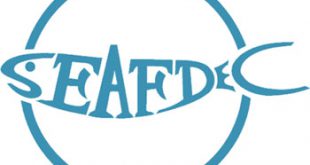The challenges facing the aquaculture industry are aplenty, and it is up to SEAFDEC Aquaculture Department (AQD) to help make innovations to sustain the industry. AQD must also help ensure that the aquatic environment maintains its integrity while fish for human food or fish for resource enhancement are produced through aquaculture. The innovations in aquaculture take the form of a simple technique (eg. feeding disinfected live food) to a complicated biotechnology tool (eg. development of vaccine). Here are two examples of useful innovations that AQD recently contributed.
Innovation for captive seahorse breeding: disinfected live food
Like most highly valued commercial species, seahorses have been very much exploited and nowhere to be found in some areas. Their international trade is now strictly regulated by international conventions like CITES. AQD breeds them in captivity for potential restocking in the wild, as part of a resource enhancement program for communities dependent on coastal resources for their livelihood.
The bottleneck for mass production has been low survival in the hatchery until a simple technique was discovered: washing the live food (eg. copepods) with low-dose formalin (30 ppt) and UV-sterilized seawater to remove adhering pathogens. The copepods – microscopic crustaceans – are replacement of the commercially available but expensive brine shrimp Artemia; they are collected from brackishwater ponds. When fed to newborn seahorses, copepods increased survival (78%) in the hatchery for 15 days after birth; in contrast, no seahorse survived when fed untreated live food. After a month, survival of seahorses fed formalin-treated copepods was 65%.
This technique could pave the way for mass breeding the seahorse Hippocampus comes, and AQD could begin experimental stock releases. While resource enhancement may be the key to conservation and rehabilitation of depleted stock seahorses, AQD is well cognizant of these important factors: (1) a partnership with the local village must be strong to make a resource enhancement project sustainable; (2) hatchery-raised seahorse juveniles to be released must come from seahorse parents that were taken from the same site to ensure and maintain genetic integrity in local waters; and (3) a well thought-out aquaculture & resource management plan can reduce risks in resource enhancement (eg. disease transmission from hatchery to indigenous fauna).
For the moment, AQD’s seahorse captive breeding studies – nursery & grow-out phases – continue at its Igang Marine Station in Guimaras, west central Philippines. These studies are under the thematic R&D program area called Quality Seed Production. AQD’s resource enhancement studies, on the other hand, are funded by GOJ-TF and are presently focused on abalone (Haliotis asisina), giant clam (Tridacna gigas) and sandfish (Holothuria scabra) and are mostly done in Sagay, northern Negros, also in central Philippines.
Innovation for marine fish hatchery: a vaccine for a viral disease
Viral nervous necrosis (VNN) is a devastating disease in cultured marine fish in Southeast Asia, and there is no cure but prevention. Although fish farmers can ensure that they do not use VNN-infected stock, the cost for screening fish broodstock, eggs and larvae by reverse transcriptase polymerase chain reaction (RT-PCR) is rather prohibitive. Screening also cannot protect stock from infection because fish are raised in openwater seacages and VNN-causing virus is widespread, if not ubiquitous, in natural waters. AQD’s innovative solution is the development of a vaccine.
The process to develop and elucidate the efficacy of the vaccine through in vitro and vivo studies, respectively, took approximately two years. First, the Philippine strain of the VNN-causing betanodavirus was propagated in live cells; second, the virus was inactivated with formalin and this vaccine immunogen was injected to a few marine fish juveniles (sea bass, grouper, pompano) that were subsequently challenged with the homologous virus at scheduled intervals after vaccination. As a result, vaccinated fish juveniles can be protected up to 6 months, time enough for fish to grow in sea cages and be harvested. With a single vaccination, survival can be 90-100% in fish experimentally exposed to betanodavirus.
AQD credits Professor Dr. Toshihiro Nakai of Hiroshima University for the cell line (called E-11) used for the propagation of the betanodavirus in vitro. Dr. Nakai’s lab is the reference laboratory for VNN as recognized by the Paris-based World Organization for Animal Health (Office International des Epizooties or OIE). AQD’s vaccination studies are funded by the GOJ-TF under its regional fish disease program.

 SEAFDEC/AQD Southeast Asian Fisheries Development Center | Aquaculture Department
SEAFDEC/AQD Southeast Asian Fisheries Development Center | Aquaculture Department
